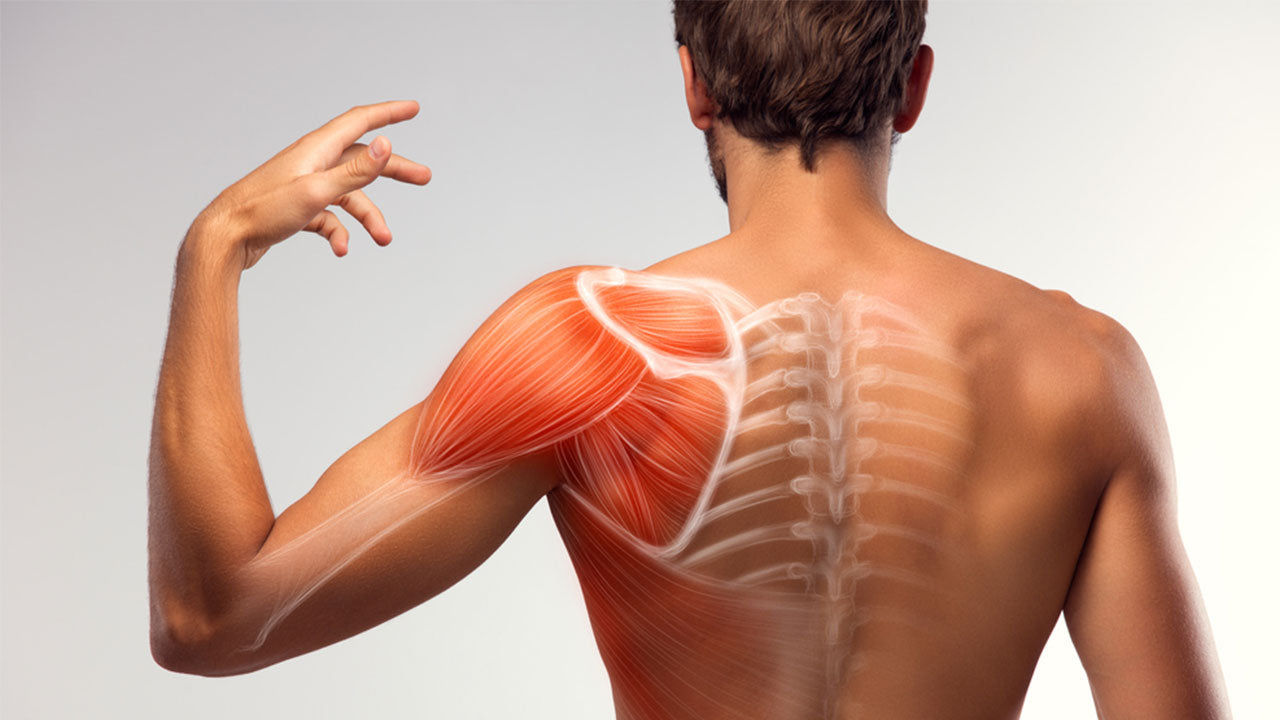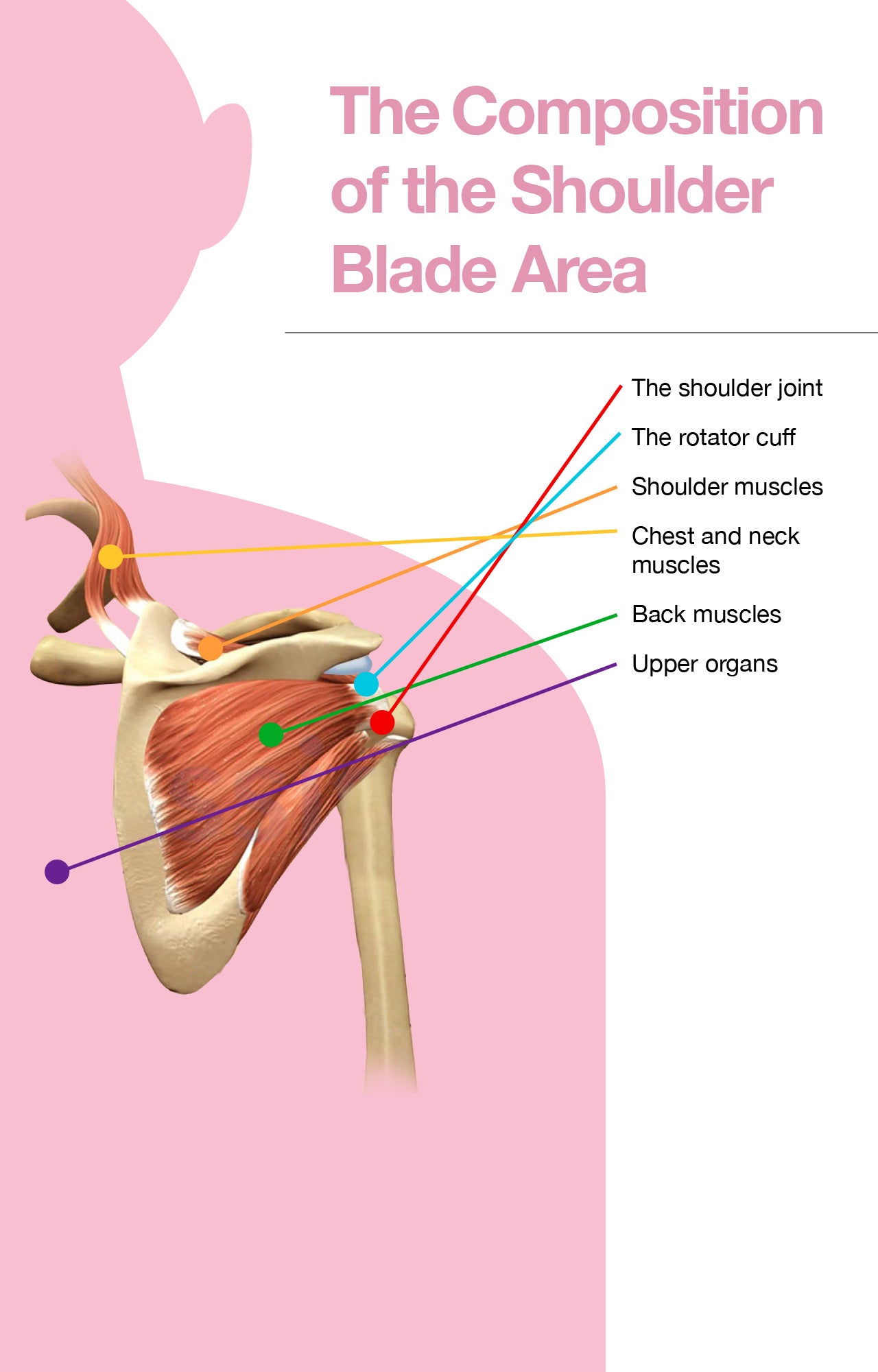Shoulder Blade Pain: Potential Causes, Treatment and Prevention
 By: by Amino Science
By: by Amino Science

If you're experiencing shoulder blade pain, it's understandable that you're concerned. Back pain in an unreachable place like your upper spine, shoulder blades, or shoulder joint could be an indication that there's something wrong with your skeletal structure, or that you may be having a heart attack. The following article details the potential causes of pain in the area of the upper back and shoulder blades.
The Composition of the Shoulder Blade Area
Your upper back and shoulder area is a busy location in the body, home to vital arteries, your spinal cord, and your lower respiratory tract. Here are the details of the anatomy surrounding your shoulder blades.
- The shoulder joint (glenohumeral joint): The shoulder is the meeting place of the scapula (the shoulder bone, shoulder blade, or wing bone) and the humerus (the upper arm bone). It's a ball-and-socket, rotating joint in close connection with the clavicle (collar bone) and the rib cage. One common cause of pain in this area is a dislocation of the joint.
- The rotator cuff: This is the common name for the group of tendons and muscles that stabilize the bones of the shoulder. Shoulder injuries involving the rotator cuff often require surgery and physical therapy to regain range of motion.
- Shoulder muscles: The teres major muscles (which attach the shoulder blades to the top of the arm bone) and deltoid muscle (which covers three sides of the shoulder joint like a cap sleeve) are also in the shoulder area and provide support for the joint as well as the ability to move the arm in full rotation.
- Chest and neck muscles: These are the serratus anterior, subclavius, pectoralis minor, sternocleidomastoid, and levator scapulae muscles. These muscles attach the ribs, sternum, and cervical vertebrae to the greater shoulder area.
- Back muscles: The rhomboid major and minor muscles (interconnected), the trapezius, the levator scapulae, and the latissimus dorsi muscles further connect your cervical vertebra and the occipital bone (skull) to the shoulder area.
- Upper organs: Your lungs, heart, aorta, subclavian artery, and more all exist in the upper region of your thorax (chest) and could be possible reasons for pain in the area.
All of that along with bundles of nerves, lymph nodes, and blood vessels can make identifying shoulder pain both difficult and in some cases vitally important.

Possible Causes of Shoulder Blade Pain
Pain within the body is not as simple to identify as external pain you can see the direct cause of. There is a phenomenon known as referred pain, meaning that pain you feel in or between your shoulder blades could be stemming from a different region of the body but showing up in the nerve ending in your upper back.
Shoulder blade pain is known as interscapular pain and could consist of any sensation from persistent discomfort to aching, soreness, or shooting pain in the area. Often this pain is the culprit of a pinched nerve or muscle (maybe you slept wrong and have to deal with shoulder and neck pain for a few days), or it could be something much more serious. Potential causes include:
- Poor posture: Sitting slumped at a desk could cause neck, shoulder blade, or upper back pain. Left unchecked it could lead to what's known as a Dowager's hump at the upper back/base of the neck and chronic pain.
- Scapulothoracic bursitis: Bursa sacs exist between certain tendons, bone joints, and muscles, including the shoulder blades, and can become irritated, inflamed, and painful, causing this overuse injury (also known as snapping scapula syndrome).
- Nerve compression: A nerve that's been pinched and has yet to recover can cause persistent shoulder pain.
- Muscle strains or tears: Exercising, lifting, or playing sports like tennis can cause pain in the shoulder, with rotator cuff tears being an all-too-common occurrence in sports medicine.
- Acid reflux: Stomach acid that flows up into the esophagus can cause burning pain in the upper chest region that may read as pain near the back and shoulder blades.
- Scoliosis: Often manifesting around the time of puberty, scoliosis is a curvature of the spine that may cause shoulder blade pain that leads to a diagnosis.
- Degenerative disc disease: Degenerating disks or an injured, bulging, or herniated disk in the spine could be felt in the upper shoulder region.
- Spinal stenosis: This is an abnormal narrowing of the spinal cavity and cord.
- Osteoarthritis: Arthritis of the joints in your spine, ribs, neck, or shoulder could cause chronic pain around your shoulder blades.
- Gallstone: The pain that occurs in your gall bladder when obstructed by a gallstone occurs below your liver in the upper right part of your abdomen and may radiate pain to your upper back. Nausea often accompanies this condition.
- Fibromyalgia: This is a full-body condition that is still not fully understood but involves aching and fatigue surrounding multiple joints, including those in the upper back. It is similar to myofascial pain syndrome in which certain trigger points can cause pain in other parts of the body.
- Cancers: Lymphomas, lung cancer, liver cancer, mesothelioma, esophageal cancer, bone cancers, and breast cancer could all cause perceived shoulder blade pain.
- Heart attack: Left shoulder blade pain could be a sign of a heart attack, as could pain in the arm on the left side of the body. This pain may be accompanied by shortness of breath and chest pain, but not always, especially among women. A suspected heart attack or any sort of heart condition (like an aortic dissection, a rupture or a pulmonary embolism in the lung) requires immediate medical attention to diagnose and treat.

How to Treat Shoulder Blade Pain
Before we get to home remedies and over-the-counter solutions, if you have a sharp pain or severe pain you can't identify, you should see a doctor right away. There are some life-threatening potential causes of pain in this area of the body, so especially if you have accompanying symptoms like shortness of breath, chest pain, or other dangerous physical symptoms like swelling legs, loss of vision, fever, excessive sweating, lightheadedness, fainting, irregular heartbeat, difficulty speaking, coughing up blood, or paralysis, seek immediate professional medical care.
However, if the pain you're feeling is a result of injury or a normal ache and not severe enough to require a doctor or physical therapist, here are some DIY solutions for shoulder blade pain.
- Muscle support supplements: If you have a muscle injury, the best way to speed up healing naturally is to choose amino acid supplements before turning to pain medications. Muscle repair requires new protein synthesis, and new protein synthesis cannot be done without all nine of the essential amino acids that create new muscle cells.
- Stretching: Yoga and other stretching techniques can aid with pain relief, alleviate stiffening, and help you avoid future injuries. To start with a simple stretch, cross one arm over your chest, use the other to pull your elbow closer to your ribcage, and hold for at least 10 seconds.
- Exercise: Once you're stretched and limber, exercise can not only help loosen your muscles but also strengthen your back and shoulders to avoid future issues. Pull-ups, push-ups, and sit-ups can all benefit this area.
- Rest: Proper rest helps one recover from injuries, and ensuring that you have supportive pillows and mattresses can help prevent shoulder and back pain going forward.
- Hot or cold compression: For a muscle strain in this area, icing or applying a heating pad can help accelerate healing and relieve pain.
- Massage or physical therapy: For a pinched nerve or aches and pains in your upper back, a session with a masseuse or licensed physical therapist could help unkink your shoulders quickly, as in within an hour.
Over-the-counter anti-inflammatories like ibuprofen (Motrin IB and Advil) or a steroid injection from a doctor could help relieve pain as well. For more extreme injuries such as a rotator cuff tear, surgery may be required, and a doctor would advise that only if appropriate. Luckily, according to the American Academy of Orthopaedic Surgeons, 90% of those who experience upper back and shoulder blade pain are restored by nonsurgical options like exercise, rest, and time.

Avoiding Shoulder Blade Pain
While there are some dangerous injuries and conditions that can be felt around the shoulder blade, most of the aches experienced there can not only be cured but also avoided. Practice good posture, avoid lifting heavy items if at all possible, stretch regularly each morning and especially before workouts or sporting, and try not to sit too long even if you have an office job—standing and stretching just once an hour, or taking a trip to the water cooler, can help you avoid shoulder blade pain before it ever comes around again.

Up to 25% off Amino
Shop NowTAGS: conditions
Join the Community
Comments (0)
Most Craveable Recipes




 833-264-6620
833-264-6620



















